Fix: ShellExperienceHost and Cortana needed to be Installed
You may encounter the Start menu issue if the Windows and Drivers of your system are outdated. Moreover, conflicting applications like Dropbox or Adobe Creative Cloud may also cause the error at hand.
The issue arises when the Start menu of the user does not open/function and upon running the Start menu troubleshooter, the user gets the following message:
Microsoft.Windows.ShellExperienceHost and Microsoft.Windows.Cortana applications need to be installed correctly

Before proceeding, check if booting your system with the bare minimum or in the safe mode resolves the issue.
Following workarounds are reported by users to temporary solve the issue:
- Creating a new virtual desktop.
- Changing the Windows theme or reverting to the default Windows theme.
- Pressing Ctrl + Alt + Del button and choosing Switch User. Then signing in with your current user account.
- Launching the Ctfmon.exe from the following location:
C:\Windows\system32\
- Toggling (on or off) ‘Show more Tiles on Start’ in Taskbar Settings > Start tab.
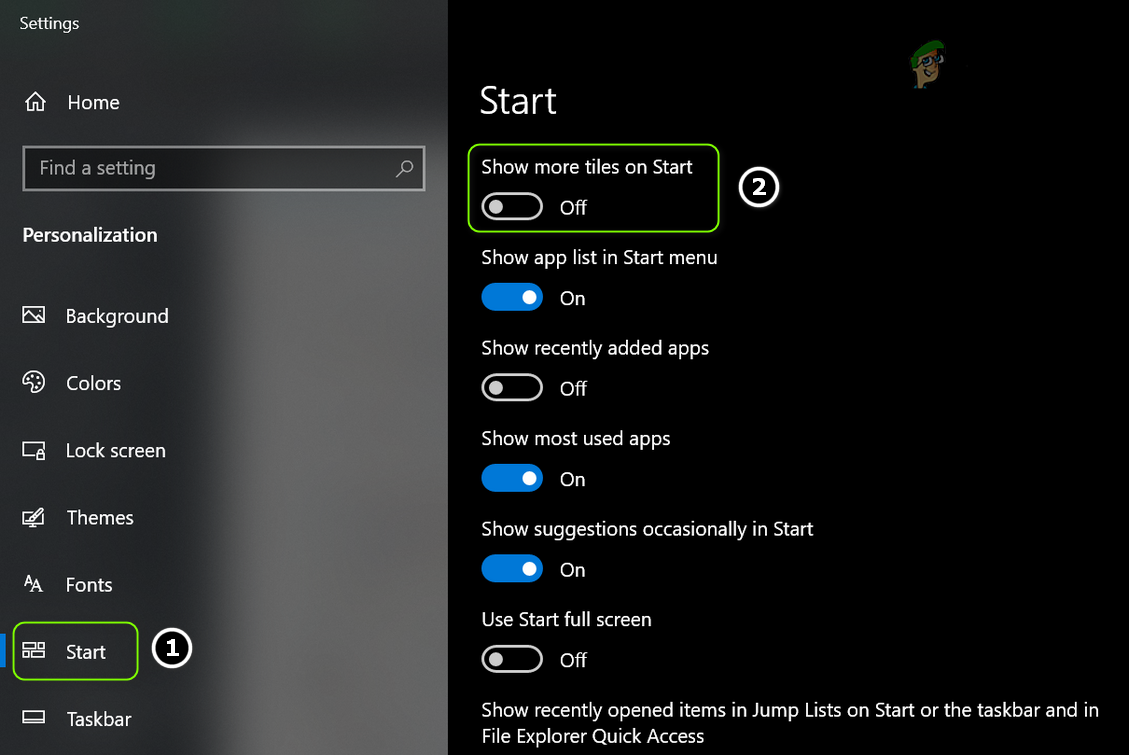
Toggle Show more Tiles on Start - Restarting the Firewall service and Windows Explorer process.
Solution 1: Update the BIOS, Drivers, and Windows of Your PC
The incompatibility between the essential system modules (i.e., BIOS, Drivers, and Windows) may cause the issue at hand as these entities are not updated to the latest builds. In this context, updating BIOS, Drivers, and Windows to the latest releases may solve the problem.
- Update the Windows of your PC to the latest build (you may need to open Setting via executing “ms-settings:windowsupdate” in the Run command box). You can also use the offline installer of the latest Windows update.

Launch Windows Update Through the Run Box - Then update the drivers of your PC to the latest build (you may right-click on This PC and choose Manage). Make sure the BIOS of your system is also updated. If you are using an update utility by the OEM (e.g., Dell Support Assistant), then use that utility to update the system’s drivers. If you are using an external graphics card, then make sure to update its drivers through the OEM application (like NVIDIA GeForce Experience).

Open Computer Management - Now check if the system is clear of the applications’ error.
- If not, then launch a web browser and navigate to the OEM website (for example, HP or Nvidia website).
- Now download the drivers for your PC and install the drivers with the administrator privileges.
- Then reboot your PC and check if the Start menu issue is resolved.
Solution 2: Disable/Remove the Conflicting Applications
You may encounter the issue at hand if any of the installed applications is hindering the operation of the essential OS entities. In this case, removing the conflicting applications may solve the problem. As the Start menu is not working, you have to dig deeper to make these instructions work for you.
- Boot your computer into safe mode and then clean boot it to check if the issue is resolved.
- If so, then you may enable processes/applications/services one by one (that were disabled during the clean boot process) till you find the problematic one.
Once the problematic application is found, you may keep it disabled at the system’s start or uninstall it. Following applications are reported by the users to create the issue:
- AppLocker (a tool used by I.T. administrators to secure the infrastructure)
- Adobe Creative Cloud
- CorelDraw
- Dropbox
- Comodo Internet Security (it will be better to check if the antivirus of your system is not creating the issue).
For elucidation, we will discuss the process for Dropbox (make sure to back up the essentials).
- Launch the Run command box (by simultaneously pressing Windows + R keys) and execute (make sure to enter the colon at the end):
ms-settings:

Open the System’s Settings Through the Run Box - Then open Apps and then expand Dropbox.

Open Apps in the Windows Settings - Now click on Uninstall and then confirm to uninstall Dropbox.

Uninstall the Dropbox Application - Then let the uninstallation complete and reboot your PC.
- Upon reboot, check if the Start menu issue is resolved. If so, then you may install the latest version of the problematic application.
If the issue persists, then check if disabling the Fast Startup sorts out the Start menu problem.
Solution 3: Reinstall the Graphics Driver
The corrupt graphics driver (the Nvidia drivers are reported to create the issue) may also cause the start menu issue at hand. In this context, reinstalling the graphics driver may solve the problem.
- Launch a web browser and navigate to the website of the graphics driver manufacturer (like the Nvidia website).
- Then download and install (with administrator privileges) the latest drivers for your graphics adapter.
- Now reboot your PC and check if the start menu issue is resolved.
- If not, then right-click on This PC and choose Manage (or execute ‘devmgmt.msc’ in the Run command box). If that is not an option, then you may try the following steps in safe mode.

Run the devmgmt.msc Command - Now expand the option of Display Adapters and right-click on the graphics device (e.g., Nvidia graphics card).
- Then select Uninstall Device and in the window shown, checkmark the option of Delete the Driver Software for This Device.
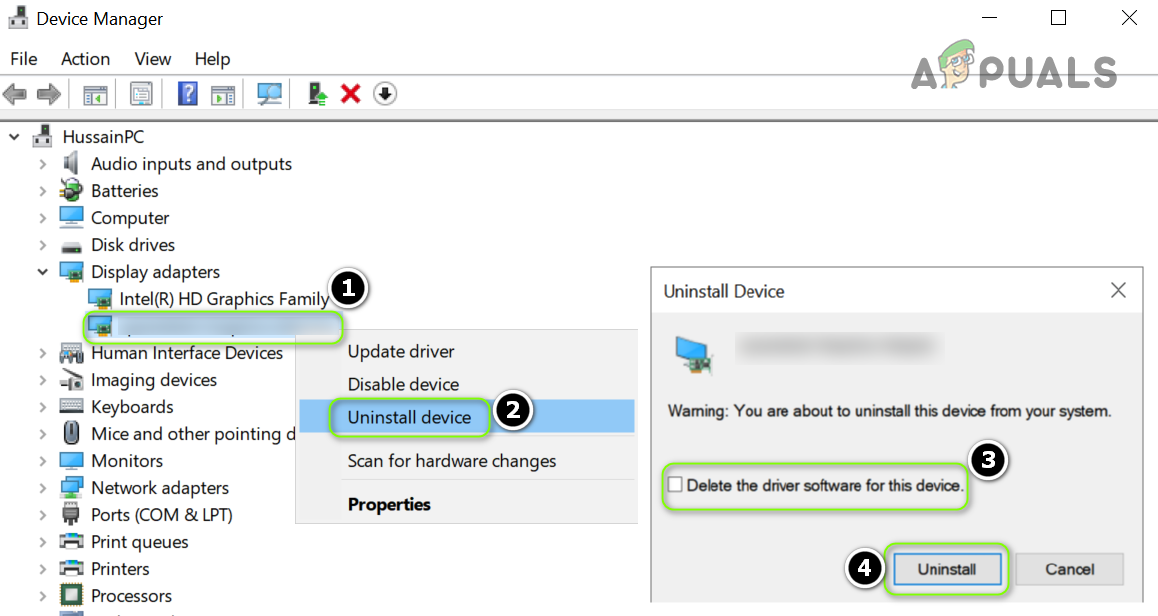
Uninstall the Graphics Driver of the 2nd Monitor - Now click on Uninstall and let the uninstallation of the graphics driver complete.
- Then reboot your PC and upon reboot, let Windows install the default drivers and check if the system’s start menu is functioning normally.
- If not, install the downloaded driver at step 2 and check if the start menu problem is solved.
- If not, then repeat steps 4 to 6, but at step 6, disable the graphics card and check if the start menu is operating normally. If that is not an option, then check if disabling the graphics card in the system’s BIOS solves the problem.
Solution 4: Edit the System’s Registry
If none of the solutions has worked for you, then editing the related registry keys may solve the problem. But keep in mind that these keys may not be available to all users.
Warning: Progress at your own risk and with the extrema care as editing the system’s registry is a skillful task and if not done properly, you may cause everlasting damage to your data/PC.
Before advancing, make sure to back up your system’s registry.
Disable WpnUserService
- Press Windows + R keys and in the Run box, type: Regedit. Then press the Ctrl + Shift + Enter keys to launch the editor as administrator. If that is not an option, then launch the Registry Editor in the safe mode or use the Command Prompt/Task Manager.

Run the RegEdit Command - Navigate to the following path:
Computer\HKEY_LOCAL_MACHINE\SYSTEM\CurrentControlSet\Services\WpnUserService
- Now, in the right pane, double-click on Start and changes its value to 4.

Disable the WpnUserService - Then exit the editor and reboot your PC to check if the Start menu has started to work fine.
Edit Permission of HKEY_CLASSES_ROOT
- Launch the Registry Editor (as discussed above) and navigate to the following:
Computer\HKEY_CLASSES_ROOT
- Now, in the left pane, right-click on HKEY_CLASSES_ROOT and choose Permissions.

Open Permissions of HKEY_CLASSES_ROOT - Then check if All Application Packages is listed in the section of Group or User Name. If so, proceed to step 6.
- If All Application Packages is not present, click on Add and then click on the Advanced button.

Click on the Add Button in the HKEY_CLASSES_ROOT Permissions - Now click on Find Now and then, in the results shown, double-click on All Application Packages.

Double-Click All Application Packages - Then click on OK and then, in the Group or User Names, select All Application Packages.
- Now, in the section of Permissions for All Application Packages, make sure only Read permission is selected in the Allow column.
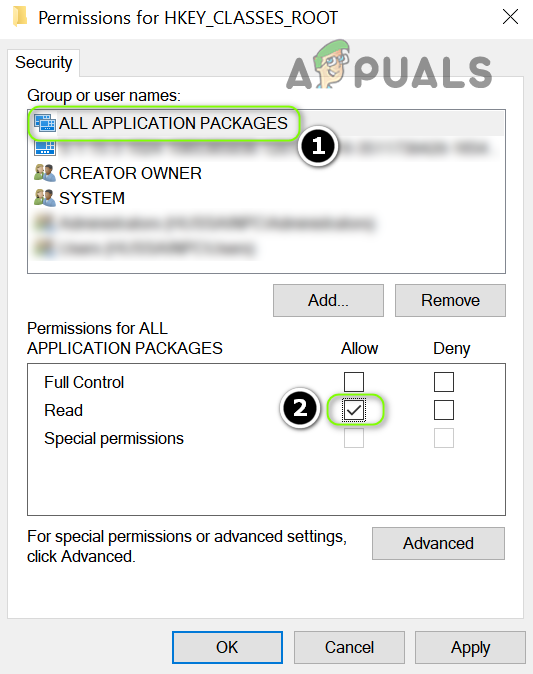
Set the Permission of All Application Packages to Read - Then Apply your changes and reboot your PC after exiting the editor.
- Upon reboot, check if the Start menu issue is sorted out.
Delete the Search Key
- Open the Registry Editor and navigate to the following path:
HKEY_CURRENT_USER\SOFTWARE\Microsoft\Windows\CurrentVersion\Search
- Then, in the left pane, right-click on Search and select Delete.
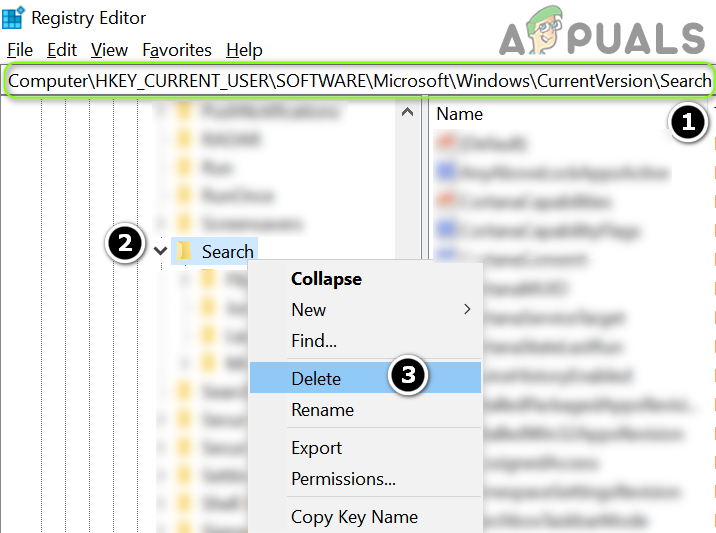
Delete the Search Key - Now confirm to delete the key and reboot your PC after exiting the editor.
- Upon reboot, check if the Start menu is clear of the error.
Reset the DCOM Permissions
- If your event log is also showing some DCOM errors, then launch the Registry Editor and navigate to the following:
HKEY_LOCAL_MACHINE\SOFTWARE\Microsoft\Ole
- Then, in the right pane, delete the following keys:
DefaultAccessPermission DefaultLaunchPermission MachineAccessRestriction MachineLaunchRestriction
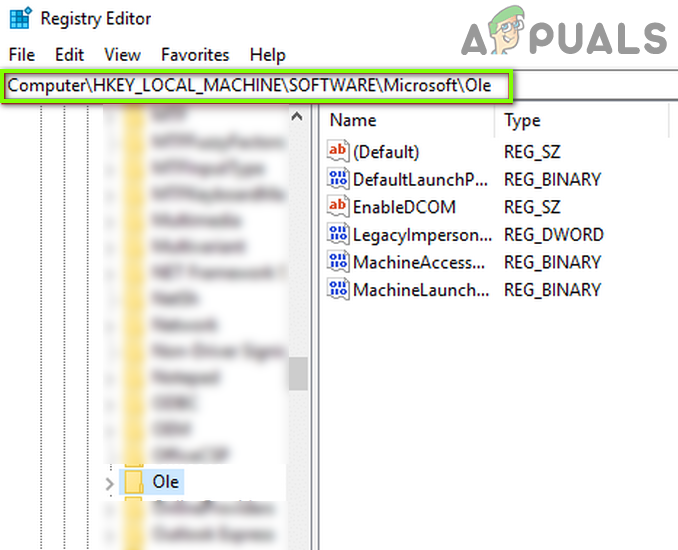
Delete the Values in OLE Key - Now exit the editor and reboot your PC to check if the Start menu issue is resolved.
Solution 5: Use the PowerShell Commands
If the issue is still there, then you can reinstall the Windows Start menu by reregistering the Windows 10 apps through the PowerShell which may solve the problem.
Launch the Administrator PowerShell
As the Start menu and Cortana are not working, we may have to try some alternative ways to open the PowerShell.
- Right-click on the Start menu button and in the Quick Access menu, choose Windows PowerShell (Admin).
- If that did not do the trick, press Windows + R keys (to launch the Run box) and type: PowerShell. Now press Ctrl + Shift + Enter keys to launch the PowerShell as administrator.
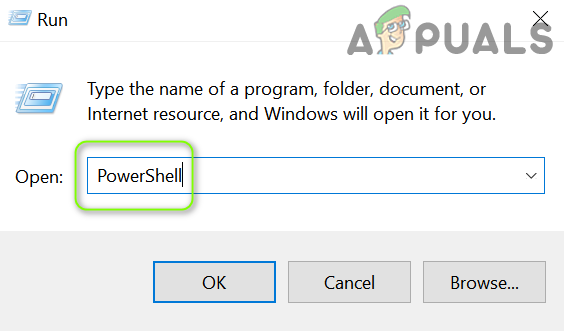
Open the PowerShell Through the Run Command - If that is not an option, then launch the Task Manager (Ctrl + Alt + Delete keys) and open the File menu. Then select Run a New Task and type: PowerShell. Now checkmark Create This Task with Administrator Privileges and click on OK.
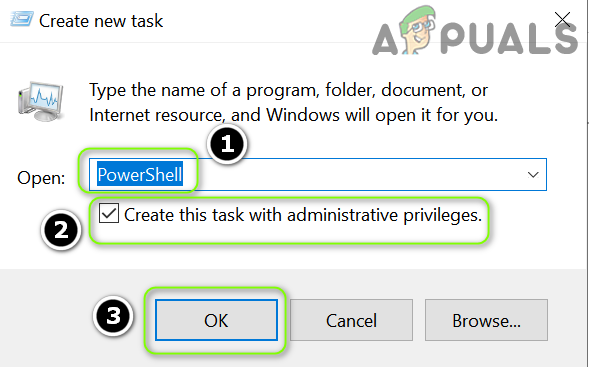
Open the PowerShell Through the Task Manager - If you still cannot launch the PowerShell, then launch the PowerShell.exe as administrator from the following:
\Windows\System32\WindowsPowerShell\v1.0
Reinstall the Windows 10 Apps
- Now execute the following one by one:
Get-AppXPackage -AllUsers | Foreach {Add-AppxPackage -DisableDevelopmentMode -Register "$($_.InstallLocation)\AppXManifest.xml"} Get-appxpackage -all *shellexperience* -packagetype bundle |% {add-appxpackage -register -disabledevelopmentmode ($_.installlocation + “\appxmetadata\appxbundlemanifest.xml”)} - Then check if the Start menu issue is resolved.
Reregister the Cortana and ShellExperienceHost
- In the PowerShell, execute the following one by one:
Get-AppxPackage Microsoft.Windows.ShellExperienceHost | Foreach {Add-AppxPackage -DisableDevelopmentMode -Register "$($_.InstallLocation)\AppXManifest.xml"} Get-AppxPackage Microsoft.Windows.Cortana | Foreach {Add-AppxPackage -DisableDevelopmentMode -Register "$($_.InstallLocation)\AppXManifest.xml"}
ReRegister the ShellExperienceHost - Now check if the Start menu issue is resolved.
Use the Local AppxPackage
- Execute the following one by one:
Add-AppxPackage -register "C:\Windows\SystemApps\Microsoft.Windows.Cortana_cw5n1h2txyewy\appxmanifest.xml" -DisableDevelopmentMode Add-AppxPackage -register "C:\Windows\SystemApps\ShellExperienceHost_cw5n1h2txyewy\appxmanifest.xml" -DisableDevelopmentMode

Use the Local Appx Packages - Then check if the package issue is resolved.
Reinstall the Applications for All Users
- Execute the following one by one:
Get-AppXPackage -AllUsers |Where-Object {$_.InstallLocation -like "*SystemApps*"} | Foreach {Add-AppxPackage -DisableDevelopmentMode -Register "$($_.InstallLocation)\AppXManifest.xml"} Get-AppXPackage -AllUsers |Where-Object {$_.InstallLocation -like "*Cortana*"} | Foreach {Add-AppxPackage -DisableDevelopmentMode -Register "$($_.InstallLocation)\AppXManifest.xml"} Get-AppXPackage -AllUsers |Where-Object {$_.InstallLocation -like "*ShellExperienceHost*"} | Foreach {Add-AppxPackage -DisableDevelopmentMode -Register "$($_.InstallLocation)\AppXManifest.xml"} - Then check if the Start menu is working fine.
Solution 6: Create a New Windows Account
The Start menu issue may arise if your Windows user profile is corrupt. In this context, creating another Windows user account may solve the problem.
- On your Desktop, right-click on the icon of This PC and choose Manage.
- Now, in the left pane, expand ‘Local Users and Groups’ and right-click on Users.
- Then select ‘New User…’ and fill-out the details.

Create a New User in Local Users and Groups - Now logout of the current user and log into the newly created account to check if the Start menu issue is resolved. If so, then you may transfer the user data to the new profile and delete the old one.
If you cannot open Computer Management at step 1, then you may execute ‘control userpasswords2’ in the Run command box to open the user management window.
If you cannot open the Run command box, then you may execute any one of the following in an Administrator Command Prompt to add the new user account (you may execute it in the Advanced Options in Troubleshoot):
net user "username" "password" /add net user /add Admin2 net localgroup administrators Admin2 /add

If the issue is still there, then you may perform a DISM scan of your PC. If that did not do the trick, then you either perform an In-Place Upgrade or a clean installation of Windows.





